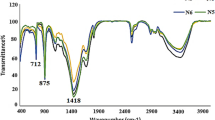Abstract
We examined the effectiveness of using different calcium salts for bioconsolidation. Four calcium salts were chosen based on their applicability and solubility. Initial experiments demonstrated that the addition of any calcium salt had a negative effect on the urease activity of S. pasteurii. Microscopic examinations elucidated the morphological and structural differences of the calcium carbonate (CaCO3) crystals induced. Calcite and vaterite are the prominent forms of CaCO3 detected according to X-ray diffraction (XRD) analysis. Bioconsolidated sand samples were able to significantly resist water flow through a column compared to the non-treated samples. Also, in a tightness test, the differences in the ability to retain water within columns were observed among the samples tested. Moreover, despite the differences, the calcium salts tested still bound the sand together to form blocks. Our results further explain the influence of multiple factors in crystal formation and sand bioconsolidation effectiveness.
Similar content being viewed by others
References
DeJong, J. T., B. M. Mortensen, B. C. Martinez, and D. C. Nelson (2010) Bio-mediated soil improvement. Ecol. Eng. 36: 197–210.
Whiffin, V. S., L. A. van Paassen, and M. P. Harkes (2007) Microbial carbonate precipitation as a soil improvement technique. Geomicrobiol. J. 24: 417–423.
Boquet, E., A. Boronat, and A. Ramos Cormenzana (1973) Production of calcite (calcium carbonate) crystals by soil bacteria is a general phenomenon. Nature 246: 527–529.
Rivadeneyra, M. A., R. Delgado, A. Del Moral, M.R. Ferrer, and A. Ramos-Cormenzana (1993) Precipitation of calcium carbonate by Vibrio spp. from an inland saltern. FEMS Microbiol. Ecol. 13: 197–204.
Kroll, R. G. (1990) Alkaliphiles. pp. 55–92. In: Edwards, C. (ed.). Microbiology of extreme environments. McGraw-Hill, NY, USA.
Stocks-Fischer, S., J. K. Galinat, and S. S. Bang (1999) Microbiological precipitation of CaCO3. Soil Biol. Biochem. 31: 1563–1571.
Hammes, F. and W. Verstraete (2002) Key roles of pH and calcium metabolism in microbial carbonate precipitation. Rev. Environ. Sci. Biotechnol. 1: 3–7.
De Muynck, W., K. Verbeken, N. De Belie, and W. Verstraete (2010) Influence of urea and calcium dosage on the effectiveness of bacterially induced carbonate precipitation on limestone. Ecol. Eng. 36: 99–111.
Natarajan, K. R. (1995) Kinetic study of the enzyme urease from Dolichos biflorus. J. Chem. Educ. 73: 556–557.
Bradford, M. M. (1976) A rapid and sensitive method for the quantitation of microgram quantities of protein utilizing the principle of protein dye binding. Anal. Biochem. 72: 248–254.
Hammes, F., N. Boon, J. De Villiers, W. Verstraete, and S. D. Siciliano (2003) Strain-specific ureolytic microbial calcium carbonate precipitation. Appl. Environ. Microbiol. 69: 4901–4909.
Mahadevan, S., R. D. Sauer, and J. D. Erfle (1977) Purification and properties of urease from bovine rumen. Biochem. J. 163: 495–501.
Perez-Perez, G. I., C. B. Gower, and M. J. Blaser (1994) Effects of cations on Helicobacter pylori urease activity, release, and stability. Infect. Immun. 62: 299–302.
Kistiakowsky, G. B., P. C. Mangelsdori, A. J. Rosenberg, and W. H. R. Shaw (1952) The effects of electrolytes on urease activity. J. Am. Chem. Soc. 74: 5015–5020.
De Yoreo, J. J. and P. G. Vekilov (2003) Principles of crystal nucleation and growth. Rev. Mineral. Geochem. 54: 57–93.
Tai, C. Y. and F. Chen (1998) Polymorphism of CaCO3 precipitated in a constant-composition environment. AIChE J. 44: 1790–1798.
Park, S., Y. Park, W. Chun, W. Kim, and S. Ghim (2010) Calciteforming bacteria for compressive strength improvement in mortar. J. Microbiol. Biotechnol. 20: 782–788.
De Muynck, W., K. Cox, N. D. Belie, and W. Verstraete (2008) Bacterial carbonate precipitation as an alternative surface treatment for concrete. Constr. Build. Mater. 22: 875–885.
Cullity, B. D. (1978) Elements of X-Ray Diffraction. 2nd ed., Addison Wesley Publishing Compnay, MA, USA.
Shirakawa, M. A., K. K. Kaminishikawahara, V. M. John, H. Kahn, and M. M. Futai (2011) Sand bioconsolidation through the precipitation of calcium carbonate by two ureolytic bacteria. Mater. Lett. 65: 1730–1733.
Achal, V., A. Mukherjee, P. C. Basu, and M. S. Reddy (2009) Strain improvement of Sporosarcina pasteurii for enhanced urease and calcite production. J. Ind. Microbiol. Biotechnol. 36: 981–988.
Author information
Authors and Affiliations
Corresponding author
Rights and permissions
About this article
Cite this article
Gorospe, C.M., Han, SH., Kim, SG. et al. Effects of different calcium salts on calcium carbonate crystal formation by Sporosarcina pasteurii KCTC 3558. Biotechnol Bioproc E 18, 903–908 (2013). https://doi.org/10.1007/s12257-013-0030-0
Received:
Revised:
Accepted:
Published:
Issue Date:
DOI: https://doi.org/10.1007/s12257-013-0030-0




